Asus A8N32-SLI Deluxe: NVIDIA Dual x16 for the Athlon 64
by Wesley Fink on November 6, 2005 9:00 AM EST- Posted in
- Motherboards
Gaming Performance
SLI
Single Video
Since the DFI and Asus were both tested with the same CPU, memory, video cards, and video drivers, let's compare performance in SLI mode as a percentage increase in the six tested games.
Using the same video drivers and components, the Asus Dual x16 was 1% to 8.1% faster than the DFI Dual x8. These increases are small enough that we took a closer look at single card performance to see if the real difference was Dual x16 or something else.
In single video card mode, we were completely surprised to find performance increases on the Asus as high as 17.3%. This is an even higher performance increase than SLI mode, but in this case, both the DFI and Asus are running a single card in x16 mode. How is this possible? We re-ran benches several times and attained the same results. It is also interesting that while there is almost no increase in single mode in "older" games, the newest and most demanding titles show the biggest increases.
Perhaps the MCP51 is more efficient than the older nF4 SLI chip, or perhaps the design of the AMD Dual x16 improves video performance across the board. Or maybe the 8-phase Asus design really makes a difference. We won't know the true answer until we do much more testing on the new Dual x16 boards. Whatever the explanations that will be found, it is clear that the Asus A8N32-SLI is slightly faster in older game titles in both single-video and SLI modes. In newer and more demanding games, the Asus can be 8% to 17% faster than the best of the current dual x8 solutions.
SLI
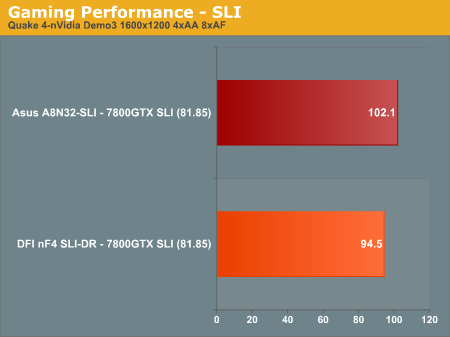
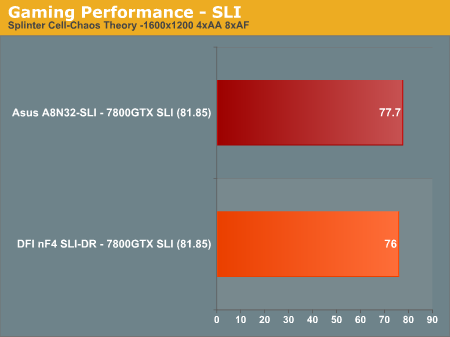
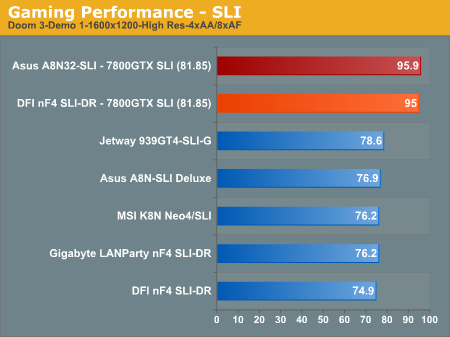
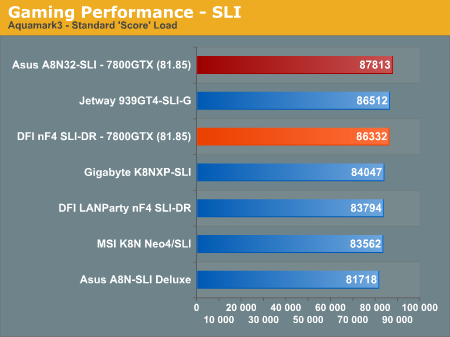
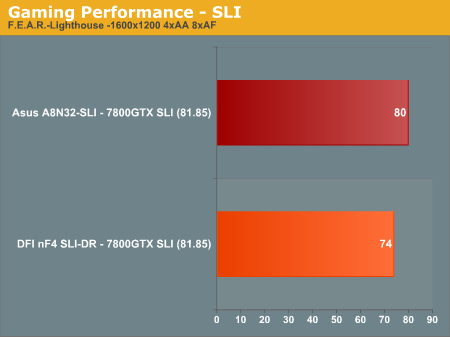

Single Video

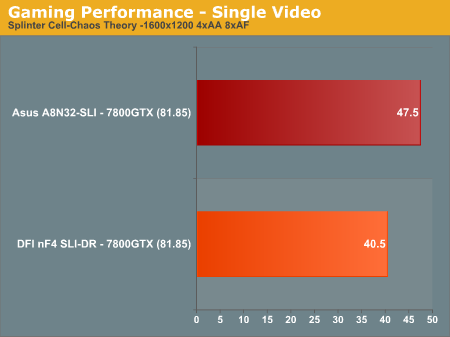
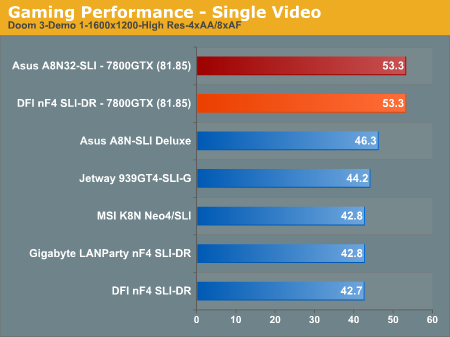
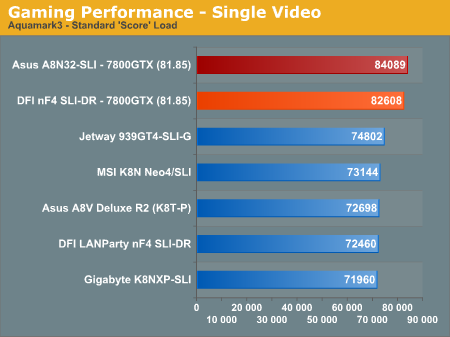


Since the DFI and Asus were both tested with the same CPU, memory, video cards, and video drivers, let's compare performance in SLI mode as a percentage increase in the six tested games.
| SLI - NVIDIA 81.85 Drivers, 6.82 Platform | |||
| Game | DFI nF4 SLI-DR (2 x8) | Asus A8N32-SLI (2 x16) | % Increase |
| Aquamark 3 | 86332 | 87813 | +1.7 |
| Far Cry | 74.3 | 78.3 | +5.4 |
| Doom 3 | 95.0 | 95.9 | +1.0 |
| Splinter Cell-Chaos Theory | 76.0 | 77.7 | +2.2 |
| Quake 4 | 94.5 | 102.1 | +8.0 |
| F.E.A.R. | 74.0 | 80 | +8.1 |
Using the same video drivers and components, the Asus Dual x16 was 1% to 8.1% faster than the DFI Dual x8. These increases are small enough that we took a closer look at single card performance to see if the real difference was Dual x16 or something else.
| Single Video - NVIDIA 81.85 Drivers, 6.82 Platform | |||
| Game | DFI nF4 SLI-DR (1 x16) | Asus A8N32-SLI (1 x16) | % Increase |
| Aquamark 3 | 82608 | 84089 | +1.8 |
| Far Cry | 47.3 | 47.5 | +0.4 |
| Doom 3 | 53.3 | 53.3 | 0.0 |
| Splinter Cell-Chaos Theory | 40.5 | 47.5 | +17.3 |
| Quake 4 | 70.1 | 78.3 | +11.7 |
| F.E.A.R. | 49 | 56 | +14.3 |
In single video card mode, we were completely surprised to find performance increases on the Asus as high as 17.3%. This is an even higher performance increase than SLI mode, but in this case, both the DFI and Asus are running a single card in x16 mode. How is this possible? We re-ran benches several times and attained the same results. It is also interesting that while there is almost no increase in single mode in "older" games, the newest and most demanding titles show the biggest increases.
Perhaps the MCP51 is more efficient than the older nF4 SLI chip, or perhaps the design of the AMD Dual x16 improves video performance across the board. Or maybe the 8-phase Asus design really makes a difference. We won't know the true answer until we do much more testing on the new Dual x16 boards. Whatever the explanations that will be found, it is clear that the Asus A8N32-SLI is slightly faster in older game titles in both single-video and SLI modes. In newer and more demanding games, the Asus can be 8% to 17% faster than the best of the current dual x8 solutions.










95 Comments
View All Comments
Zebo - Friday, November 4, 2005 - link
LOLLive - Friday, November 4, 2005 - link
The Techreport writes about overclocking with AMD Cool'n'Quiet here:They highlight two important bios options:
and with regards to memory overclocking:
Does this board have these options in bios?
As Techreport writes:
I must say I agree.
Link: http://techreport.com/etc/2005q4/damagebox/index.x...">http://techreport.com/etc/2005q4/damagebox/index.x...
DieLate - Saturday, November 5, 2005 - link
Can we get some official info on these questions?They're high on my list of features. I was all set to go with the DFI until I saw this review. These features may win me over if the ASUS has them too.
Live - Monday, November 7, 2005 - link
It looks like official reply is not going to happen. does anyone know if the Asus A8N SLI;Delux;Premium has this in later bios? If so I would bet this one has it aswell.Capt Caveman - Monday, November 7, 2005 - link
The latest bios for the Asus A8N-Sli Premium came out yesterday and no, it does not have this feature so I doubt the A8N32-Sli Deluxe will have this feature. Not very many overclocker's use CNQ, so I don't think there's a huge demand for this feature unfortunately.WobbleWobble - Friday, November 4, 2005 - link
I wonder if it's better than the DFI because of the PEG mode Asus implements on its motherboards, which overclocks the videocard.Wesley Fink - Friday, November 4, 2005 - link
And I disabled "PEG link" mode for our review. Asus has settings in PEG for Auto, Normal, Fast, Faster, and Disabled. We set "Disabled" because we know this trick. Asus suggests using "Faster" for review tests. On the positive side you have that additional performance waiting to be tapped.We also turn off the overclocks that are enabled when many boards arrive for review. That's the first thing we check.
psychobriggsy - Friday, November 4, 2005 - link
Really nice to see such diligence!Capt Caveman - Friday, November 4, 2005 - link
Not by 17%lopri - Friday, November 4, 2005 - link
Also, if you're running SLI with 2 dual-slot video cards, where are you supposed to put a sound card, or any PCI card? It seems like the only slot available will be, if it's possible at all, the one above the 2nd video card. Not sure how anyone's gonna be able to use any PCI card with SLI.